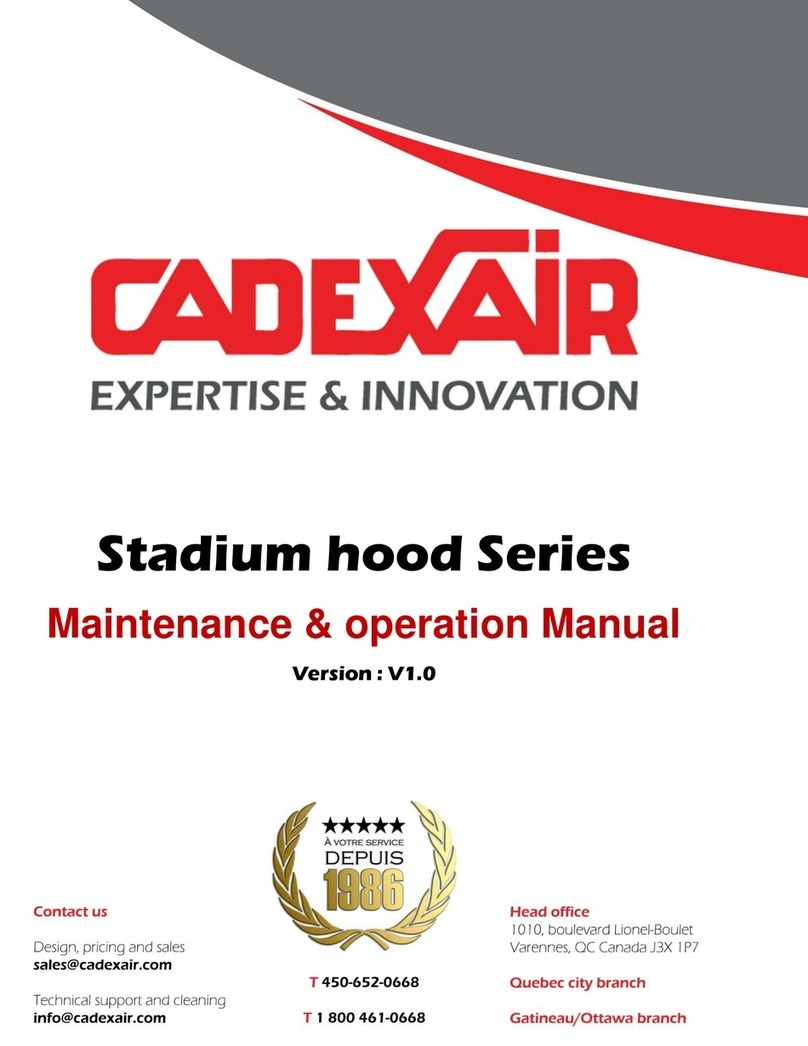
TABLE OF CONTENTS
WARNING..............................................................1
INTRODUCTION ...................................................1
GENERAL DESCRIPTION – STADIUM HOOD..2
HOMOLOGATION AND CERTIFICATION...2
BRIEF DESCRIPTION OF THE
COMPONENTS.................................................2
BILL OF MATERIALS…………...…………...3
CC200-CC50 CONTROLLER OPERATING
SEQUENCECC200-CC50 .................................4
USER INTERFACE CC50 SECTION /
STADIUM SECTION........................................4
SETTING………………………………………5
USER REQUIRED : TECHNICAL (TECH).....5
FILTER ALARMS.............................................6
FILTER OVERLOAD…………………...…….6
HIGH TEMPERATURE - FIRESTAT.……..…7
INSTALLATION………………………………….7
DELIVERY AND HANDLING…….….....…..7
CHECKING THE PARTS RECEIPT……….....7
STORAGE…………...………………………...7
SIZSING AND POSITIONING THE HOOD…8
CLEARANCE TO MATERIALS………….…9
WEIGHT VALIDATION……………………...9
LIFTING, SUSPENSION AND LEVELING.....9
CONNECTING THE EXHAUST COLLAR TO
THE HOOD…………………………………..10
PLUMBING CONNECTION FOR SELF-
CLEANING HOODS…………………………11
ELECTRICAL FITTINGS……………………11
TOP ACCESS TO HOODS……..……………11
SILICONE…………………………………….11
FIRE PROTECTION SYSTEM…………...…11
INSTALLATION AND ADJUSTEMENT OF
GEO-VARY FILTER………………………...12
AIRFLOW BALANCING…………………....12
MAINTENANCE………………………………...14
STADIUM HOOD FILTER REPLACEMENT
FREQUENCY………………………………...14
STAINLESS-STEEL MAINTENANCE……..15
INSPECTION AND MAINTENANCE OF
EXHAUST AND FIRE PROTECTION
SYSTEMS…………………………………….16
REPLACEMENT PARTS………………………..16
REMPLACEMENT FILTER ………………...16
COMPATIBLE PRODUCTS………………...16
CC20 CONTROLE BOX WITH PRESSURE
CARD…………………………………………18
HIGH LIMIT TEMPERATURE………….….18
RECESSED DEL LIGH……………………...18
APPENDIX 1 ........................................................ 19
INSTALLATING, ADJUSTING AND
CLEANING GEO-VARY FILTERS
APPENDIX 2.................................................20
APPENDIX 3.................................................22
APPENDIX 4.................................................23





























